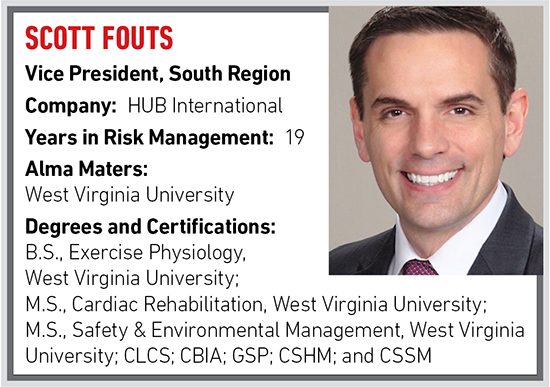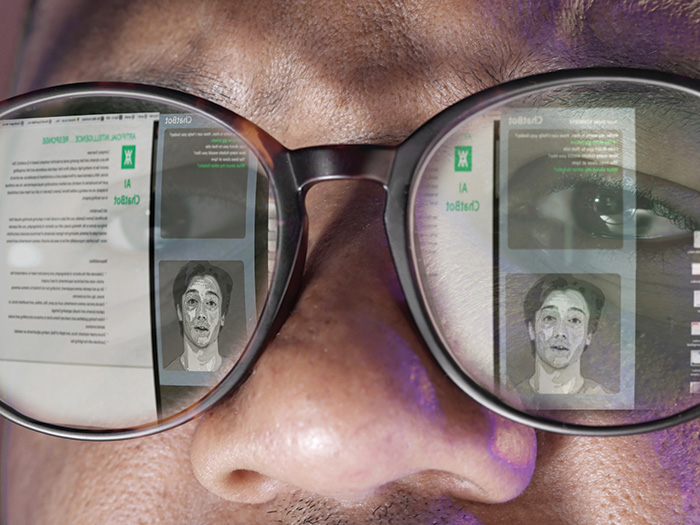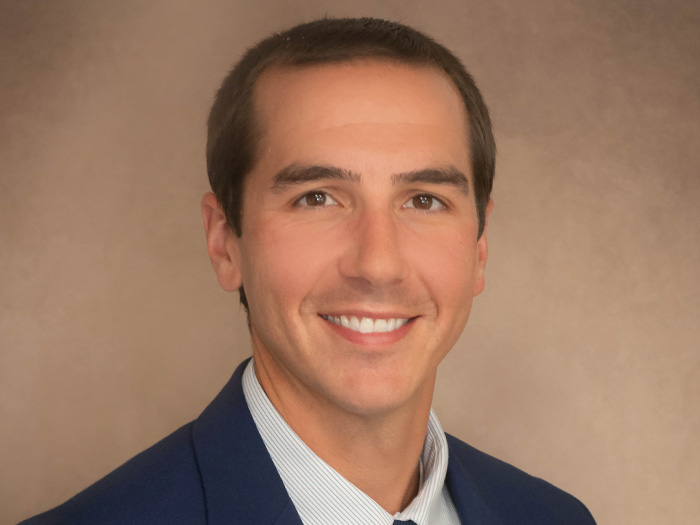This Risk Professional Shares the Need to Invest in Talent and Look Toward Technology for the Risks of the Future

R&I: What was your first job?
I was 15, and I worked at a place called Finish Line, which is a shoe store that’s still around. I grew up in a very poor town in West Virginia and that was the only way I could earn money. It was the first place that would hire me. So, I worked there and learned all kinds of things about shoes.
But as far as my first job in risk management, I worked for a company called Sareen & Associates out of college after I got my master’s in safety. It was really an opportunity to get my feet wet in the industry.
It was great to have a degree that said I knew a little bit about safety and compliance and regulatory and risk management, but to really get the experience through a consulting firm that provided me with opportunities to work with OSHA and DOT gave me a good firm foundation and helped me understand the regulatory requirement standards out there. That experience helped mold and shape my ability to get into the insurance world.
R&I: How did you come to your current position?
After that job, I ended up getting hired by a company called Hartford Insurance Group. I started as an entry-level loss-control person. I didn’t really understand insurance at the time, but I knew a little bit more about risk management and was lucky enough to have some folks who helped me kind of navigate the industry.
For about 10 years, I stayed in the field and worked myself up to a manager role there. I lived across the country, from Baltimore and D.C. all the way out west in Scottsdale and Las Vegas. Eventually, I had the opportunity to move back east to Charlotte, North Carolina and worked my way up the ranks and later took a job out of Hartford, Connecticut as the liaison between the executive teams for four of Hartford’s largest brokers — which at the time were Allianz, Willis, Gallagher and HUB.
Since I had the HUB relationship, I had the opportunity to go to Sharp, which is its awards banquet, and that year it was out in San Diego. During that time, HUB’s CEO Marty Hughes was on the stage … talking about the financial industry in 2008. From 2008 to 2009, everyone hit hard economic times, and he talked about how HUB rallied around its employees. It didn’t get rid of anybody. It didn’t give bonuses or salary increases that year, but its goal was to keep all its employees because that was the most important thing to HUB.
After he got on stage, I walked up to a gentleman named Mike Chapman. He was my connection with HUB through Hartford, and I asked him, “How do I come work for HUB? This is a company I want to work for, the culture that I want to work for, the people that I want to work for.” It spoke to me.
Within probably about a year, HUB was able to develop a role for me here in the south region where I’m at now. I started off as a consultant and worked my way into a regional leader role for the south region for HUB.
R&I: What’s been the biggest change in the risk management and insurance industry since you’ve been in it?
Every year it changes. Whether it’s coverages or artificial intelligence technology. I think, year after year, there’s always lessons to be learned.
When you think about this year, with hurricane season and a pandemic, a lot of peoples’ businesses are shut down and how insurance carriers have responded has been interesting. It’s interesting how those relationships and coverages play out.
To me, when I look at the risk management side, I look at the total cost of somebody doing business, and it’s not always about one line of business — like workers’ comp or property. Sometimes it’s the benefits and how those play out on a totally different side of the business, on the commercial side. I really understood this year how those affect our clients and the people who we do business for.
So, it’s hard to put my finger on, but I think as the industry changes, you’ll probably see a lot more technology. I think you’ll probably see a lot more artificial intelligence. I also think you’ll see coverages and insurance respond in that way as we move forward.
R&I: What’s the biggest challenge you’ve faced in your career?
Keeping up with the industry, being in the know, reading and keeping current because our customers and our clients are always looking to us for the answers when new risks arise.
When you think about the COVID-19 response, there’s been a lot of new risks that have arisen. Just think about vaccines that are rolling out right now and the employment law side of things. Can an employer make somebody get a vaccine? There’s ADA requirements and religious beliefs and union shops that will probably say “no,” and they may be in the right because of employment law that protects workers’ rights.
Making sure that you’re current on some of these risk management practices and making sure that you’re giving the right advice to clients is challenging. People are making business and operational decisions based on the advice we’re giving them. Just being off a little bit or giving the wrong advice can impact somebody’s business operations.
So, sometimes we’re in a position where we’re giving wholehearted advice and if it’s wrong, it could be catastrophic, especially when it comes to specific clients and their coverages.
R&I: What do you think risk managers should expect heading into 2021?
After the pandemic, a busy hurricane season, wildfires, earthquakes — I think business continuity is going to have to be a discussion when it comes to getting back to normal operations. I think a lot of companies and individuals found that having business continuity plans in place can help get back a business’s operations, supply chain, etc. It doesn’t have to be a pandemic, but I think a lot of carriers are going to look more at businesses to make sure they have these things in place.
If you lost this piece of your business, whether it’s a supply chain or say your facility burned down, the question is always, “How can you get back to an operational state? How fast can you get there?” And ultimately, that impacts business interruption policies, which a lot of carriers are going to look at going into 2021 and beyond.
We’re seeing a lot of insurance carriers right now looking to require formal business continuity plans to increase business interruption coverage in the southern region due to the active hurricane season.
Having those conversations with the client, understanding that the impacts to not just their insurance rates but also to getting their business back operational, will definitely be something that we have to stay out in front of in 2021 and going into the future.
R&I: Who have your mentors been and why?
I have been very lucky in my career to have a lot of mentors over the years. Some in the industry and some not. If I start out early in my career, one of my professors at school got me into this kind of unit and was always a big supporter of mine, Dr. Andrew Sorine. Then there are the mentors who helped support me at Hartford — Bill Schaffner, Karl Rosenthal and David Whisman. Then ultimately my transition to the agency side — Mike Chapman and Guy Gioino. There are a lot of people who I work with day in and day out; they’re all mentors.
I think they all took on a different role when I needed it. Some of it was teaching me to be a better leader and some of it was [about] being a better risk manager. Sometimes it’s building out my business acumen or how to be a better listener. I’ve been fortunate enough to have pretty good folks in my life to help me navigate not just the insurance industry but also the navigational beacons of life as well.
R&I: What is the risk management community doing right?
I think being transparent. If you go into LinkedIn right now and you type in ‘risk management,’ you’ll see it’s grown so much in the last 10 years.
When we used to talk about risk management, in general, it was always either OSHA or maybe DOT requirements. Now, especially when we look at our HUB complete model, we look at everything. We look at benefits. We look at the commercial side. But we also look at technology and programs and how that builds out.
Even if you Google ‘risk management’ nowadays, you’re going to see a plethora of services that are out there encompassing risk management. Risk management has grown so much, and it includes so much from employment law to other regulatory standards with the DOL, EEOC, OSH, DOT, etc.
I think companies within that do have an existing risk management community; they’ve grown their expertise and grown their knowledge base to make sure they’re supporting their insureds, their groups, and their organization. So, I think it kind of comes full circle to encompass everyone’s total cost of risk.
R&I: What could the risk management community be doing a better job of?
That’s a good question, because we’re in budget season right now. I can only speak for HUB and maybe companies that I work with, but I think [it’s] investing in talent and technology.
Whether it’s designations, continuing education or certifications, it’s always easy to pull back on that type of training, especially on the safety and risk management side. It’s usually a line item that is one of the first ones that’s cut. Sometimes that gets put on the side to maybe take in some other types of expense, but when you’re investing in your talent and providing people career paths and elevating their education, they’re only going to impact your organization in a positive way.
I think investing in educational opportunities that make sense for peoples’ businesses, not just the insurance industry. We talked about business continuity. There are designations such as Associate Business Continuity Professional ( ABCP), which is a business continuity designation that any safety professional coming out of the pandemic should be looking for to help develop plans and programs to ensure that they’re protecting the resources in their company.
That would probably be my biggest recommendation to businesses is invest in their people and realize what type of continuing education they may need to support their organization’s overall operational goals and objectives.
R&I: How would you say technology has impacted the risk management profession?
From data and analytics to the opportunity of artificial intelligence, the ability to extract data has only enhanced the information we get from different organizations or industries. Obviously, we always talk about speeding up the process of products or development and things like that. I think the data and analytics and the information that we get from that technology is exceptional.
I’ll use telematics as a great example. There are vendors out there, like Progressive or other companies that have the snapshot plug-and-play that shows driver behavior. But what that really does is it teaches risk managers. It teaches companies that these are bad driving habits — distracted driving, hard breaking, speeding — that your folks are doing.
That data, if no one does anything with it, it’s just data. But what you can do is slice and dice it and make it important to your organization.
Again, using telematics as an example, drivers who are speeding or hard breaking or in a rush or idle time, or what have you, those drivers are typically the ones you see on the loss run and are the drivers having accidents.
As we move forward, many companies will invest in equipment technology, artificial intelligence, autonomous vehicles, telematics and other services to support their businesses to help improve their losses and day-to-day efficiencies.
R&I: What’s your favorite book or movie?
Favorite book, probably The 48 Laws of Power by Robert Greene or Taking the Stairs by Rory Vaden. Favorite movie, I’d say ‘Anchorman’ or ‘Wedding Crashers.’
R&I: What is your favorite drink?
Easiest question: Jameson Whiskey — neat.
R&I: What have you accomplished that you are proudest of?
I go back to this story all the time. My life is probably a little bit different than most, but graduating college and getting my first job is what I’m proudest of in my life. It led me to where I am today to develop a hard work ethic.
I came from a really bad situation in West Virginia, but I think making it out of there is something I’m proud of when I look back at my life. I still remember telling my mentor at that time, Dr. Andrew Sorine, “If I can make $30K-$50K and make my own schedule, I would have made it.”
R&I: What is the riskiest activity you’ve ever engaged in?
Being a risk manager, I’ll probably have to plead the fifth on that one. &










